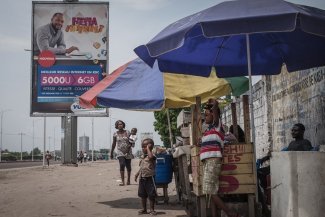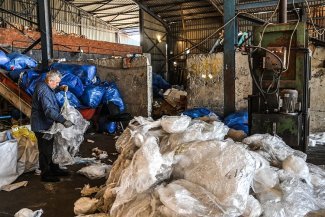
Members of the organisation for victims of asbestos during an awareness-raising campaign in the streets of Osasco, on 27 April 2017. In Brazil, the Health Ministry registered 2,400 asbestos-related deaths between the years 2000 and 2011.
Brazil, the world’s third largest asbestos producer, a major exporter and consumer, has not yet placed a total ban on the use of this insulating material once considered a “miracle product” but now recognised as carcinogenic by the World Health Organisation (WHO).
For the victims’ families and occupational health specialists, the country’s legislators have been wavering for far too long.
Seventy-six-year-old Mauricio Mendes is still hoping to see the day when his lung disease will be recognised and compensated, after a two-decade-long battle. His former employer, Eternit, received a court order to pay him damages of R$250,000 (US$80,000), but the former laboratory technician, who worked for 14 years at the Eternit factory in Osasco on the outskirts of São Paulo, may never see the colour of the money. The asbestos-cement giant has filed a fresh appeal.
“I was diagnosed in 1998, almost 20 years after leaving the company. The legal process is extremely lengthy. You have to go through a series of medical examinations certified by experts. The judges themselves still have very little knowledge about the effects of asbestos,” he explains.
For the Roncadin family, however, there is no hope left. José, the father of the family, died after losing two court cases in which the justice system failed to recognise the cause of his mesothelioma, a rare, incurable and very aggressive type of cancer from which people usually die within a year.
He also worked at Eternit in Osasco. He used to spend the whole day mixing asbestos-based preparations “without any kind of protection”, his son Vanderlei tells Equal Times.
According to the WHO, 125 million workers around the world are still exposed to asbestos today. The extent of its long-term health effects remains to be seen, as the symptoms can develop many years after exposure.
According to the international organisation’s estimates, the number of deaths attributed to the fibre per year is around 107,000. In Brazil, 2,400 asbestos-related deaths were registered by the Health Ministry between the years 2000 and 2011.
But many of the people suffering from asbestos-related diseases are not diagnosed and recognised as such.
“There is a serious lack of information and knowledge among the population, health organisations and the justice system regarding the risks and repercussions of asbestos,” underlines Fernanda Giannasi, a retired labour inspector and founder of ABREA, an association for people exposed to asbestos.
Fernanda, who has been working as a volunteer since the association was founded in 1995, has seen many people die, asbestos victims who came to the association for support and legal assistance. “We are regularly attacked by lobbies and trade unions, which accuse us of trying to destroy jobs, but things are moving forward, although we are still a long way behind Europe,” she says.
Slow progress
As of the end of the 19th century, this fibrous mineral substance was widely used around the world for its insulating properties and its resistance, to fire in particular. Long described as a “magical fibre”, it has been used in over 3,000 technical and industrial applications. It can be found in walls, ceilings and pipes as well as in toys, certain fabrics or brake and clutch systems.
In Brazil, and many developing countries, asbestos is widely used to make low-cost roofing and domestic water tanks, common in regions where the water supply is unreliable.
“The state is still encouraging the use of asbestos today, through its programmes to build social housing. Even the government agency in charge of indigenous affairs, FUNAI, provides indigenous communities with construction materials made from it,” denounces Fernanda Giannasi.
Its damaging health effects have been known since the 1930s and yet industrialists continued to use the fibre until the end of 1990s, when developed countries, such as the United States and France, began legislating to ban its use.
It is now totally banned in almost 70 countries. In Brazil, eight federal states out of 26, the latest being Santa Catarina, which voted to ban it at the end of January, have adopted prohibitive measures in the interest of protecting public health.
Brazil’s federal law continues to permit the extraction, use and commercialisation of Chrysotile (white asbestos), at national level, combined with security requirements for the 5000 or so workers handling the substance.
The Brazilian Institute of Chrysotile, IBC, which brings together companies and workers’ unions assures Equal Times that every precaution is taken to control the health risks to both the miners and workers in the sector.
“Things have changed a great deal over the last 30 years. We are now close to zero risk,” says Adilson Santana, vice president of the National Committee of Asbestos Workers, the CNTA.
“All the work the trade unions have done to establish standards and controls will be swept aside if a total ban is adopted,” he decries. For the president of the IBC, Marcondes Bragade Moraes, “The Chrysotile industry is the target of a trade war.”
With 150,000 indirect jobs on the line, the economic stakes remain high, as Brazil is one of the few countries that still has extraction sites.
The only asbestos mine still in operation in South America is located in Minaçu. Chrysotile is the main source of income in this small town of 30,000 inhabitants, in the state of Goias, to the north of Brasilia.
The mine, which now belongs to Eternit after being owned by Saint-Gobain from many years, has a production capacity of 24,000 tonnes a year and provides around 1000 direct or indirect jobs. Its deposits could be exploited for another 20 years, but the people of the region fear the mine will be closed down before then.
In addition to the public awareness raising initiatives conducted by associations such as ABREA, prosecutors from the Public Labour Prosecutions Office, the MPT, launched a programme in 2013 to encourage the companies in the sector to develop alternative activities.
“We are conducting investigations into the working conditions in the sector but we don’t believe it is possible to keep a perfect check on the security measures required by law. So we have engaged in a dialogue with the companies to seek agreements to encourage the industry to abandon the use of asbestos in its manufacturing processes,” explains Márcia Kamei Lopez Aliaga, the MPT prosecutor in charge of the national programme for the banning of asbestos.
For Fernanda Giannasi, market forces are more likely to bring an end to asbestos before Brazil’s legislators do: “It is a global trend and Brazil, as an exporting country, will continue to be affected by the fall in demand. There is a kind of domino effect. Canada, which used to have a large market share, has announced that asbestos will be banned by 2018.”
Márcia Kamei Lopez Aliaga, from the Public Labour Prosecutions Office, shares her view: “One thing is for sure, the health scandal is just as serious, if not more so, than that seen in Europe.”
It is just that Brazil has not yet acknowledged it.










